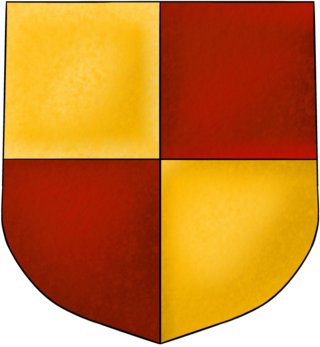
Sicyon or Sikyōn was an ancient Greek city state situated in the northern Peloponnesus between Corinth and Achaea on the territory of the present-day regional unit of Corinthia. The ruins lie just west of the modern village of Sikyona. An ancient monarchy at the times of the Trojan War, the city was ruled by a number of tyrants during the Archaic and Classical period and became a democracy in the 3rd century BC. Sicyon was celebrated for its contributions to ancient Greek art, producing many famous painters and sculptors. In Hellenistic times it was also the home of Aratus of Sicyon, the leader of the Achaean League.
During the late Middle Ages, the two cities of Argos and Nauplia formed a lordship within the Frankish-ruled Morea in southern Greece.

Theodore II Palaiologos or Palaeologus was Despot in the Morea from 1407 to 1443 and in Selymbria from then until his death.

Theodore I Palaiologos was despot (despotēs) in the Morea from 1383 until his death on 24 June 1407. A son of Emperor John V Palaiologos, Theodore was the first member of the Palaiologos dynasty appointed as the Despot of the Morea, following the final defeat of the rival Kantakouzenos clan, who under John VI Kantakouzenos had attempted to usurp rule of the Byzantine Empire.
Carlo I Tocco was the hereditary Count palatine of Cephalonia and Zakynthos from 1376, and ruled as the Despot of Epirus from 1411 until his death on July 4, 1429.

Centurione II AsanesZaccaria, scion of a powerful Genoese merchant family established in the Morea since the marriage of the lord of Chios Martino Zaccaria to the baroness Jacqueline de la Roche. Centurione was installed as Prince of Achaea by Ladislaus of Naples in 1404 and was the last ruler of the once Latin Empire not under Byzantine suzerainty.

Nerio I Acciaioli or Acciajuoli was the de facto Duke of Athens from 1385 to 1388, after which he reigned uncontested until his death in 1394. Born to a family of Florentine bankers, he became the principal agent of his influential kinsman, Niccolò Acciaioli, in Frankish Greece in 1360. He purchased large domains in the Principality of Achaea and administered them independently of the absent princes. He hired mercenaries and conquered Megara, a strategically important fortress in the Duchy of Athens, in 1374 or 1375. His troops again invaded the duchy in 1385. The Catalans who remained loyal to King Peter IV of Aragon could only keep the Acropolis of Athens, but they were also forced into surrender in 1388.

Antonio I Acciaioli, also known as Anthony I Acciaioli or Antonio I Acciajuoli, was Duke of Athens from 1403.
Theodora Tocco was the first wife of Constantine Palaiologos while he was Despot of Morea. Her husband would become the last Emperor of the Eastern Roman Empire.

The Morea revolt of 1453–1454 was a failed peasant rebellion carried out against the rule of the brothers Thomas and Demetrios Palaiologos, rulers of the Byzantine Despotate of the Morea in the Peloponnese peninsula.

The House of Tocco was an Italian noble family from Benevento that came to prominence in the late 14th and 15th centuries, when they ruled various territories in western Greece as Counts Palatine of Cephalonia and Zakynthos and Despots of Epirus. During their brief period of rule in Greece, they were one of the most ambitious and able Latin dynasties in the region, and they were one of the few to leave descendants lasting until modern times.

The Battle of the Echinades was fought in 1427 among the Echinades islands off western Greece between the fleets of Carlo I Tocco and the Byzantine Empire. The battle was a decisive Byzantine victory, the last in the Empire's naval history, and led to the consolidation of the Peloponnese under the Byzantine Despotate of the Morea.
Turahanoğlu Ömer Bey was an Ottoman general and governor. The son of the famed Turahan Bey, he was active chiefly in southern Greece: he fought in the Morea against both the Byzantines in the 1440s and 1450s and against the Venetians in the 1460s, while in 1456, he conquered the Latin Duchy of Athens. He also fought in Albania, north-east Italy, Wallachia and Anatolia.
Leonardo II Tocco was a scion of the Tocco family and lord of Zakynthos, who played an important role as a military leader for his brother, Carlo I Tocco, in early 15th-century western Greece.
Helena Asanina Kantakouzene was regent of the Lordship of Salona in Frankish Greece from 1382 until its conquest by the Ottoman Empire in 1394 on behalf of her daughter Maria Fadrique.
Carlo III Tocco (1464–1518) was the titular despot of Epirus and count palatine of Cephalonia and Zakynthos from the death of his father Leonardo III Tocco c. 1503 to his own death in 1518. Carlo lived in Rome, where he received pensions from both the Papacy and the Kingdom of Naples. As an adult, Carlo worked as a military officer, serving both the Papacy and Emperor Maximilian I.
Paolo Foscari was a Venetian noble and churchman, who rose to become Bishop of Castello in 1367–1375, and Latin Archbishop of Patras from 1375 until his death in 1393/4. In the latter capacity he played a leading role in the affairs of the Principality of Achaea.
Francesca Acciaioli or Acciajuoli was the wife of Carlo I Tocco, Count Palatine of Cephalonia and Zakynthos.
Don Antonio Tocco was the last titular Despot of Epirus and Count Palatine of Cephalonia and Zakynthos, claiming these titles from the death of his father Leonardo V Tocco in 1641 until he abandoned them in 1642, substituting them for the title of Prince of Achaea, which he used until his death in 1678.

The Ottoman conquest of the Morea occurred in two phases, in 1458 and 1460, and marked the end of the Despotate of the Morea, one of the last remnants of the Byzantine Empire, which had been extinguished in the Fall of Constantinople in 1453.










